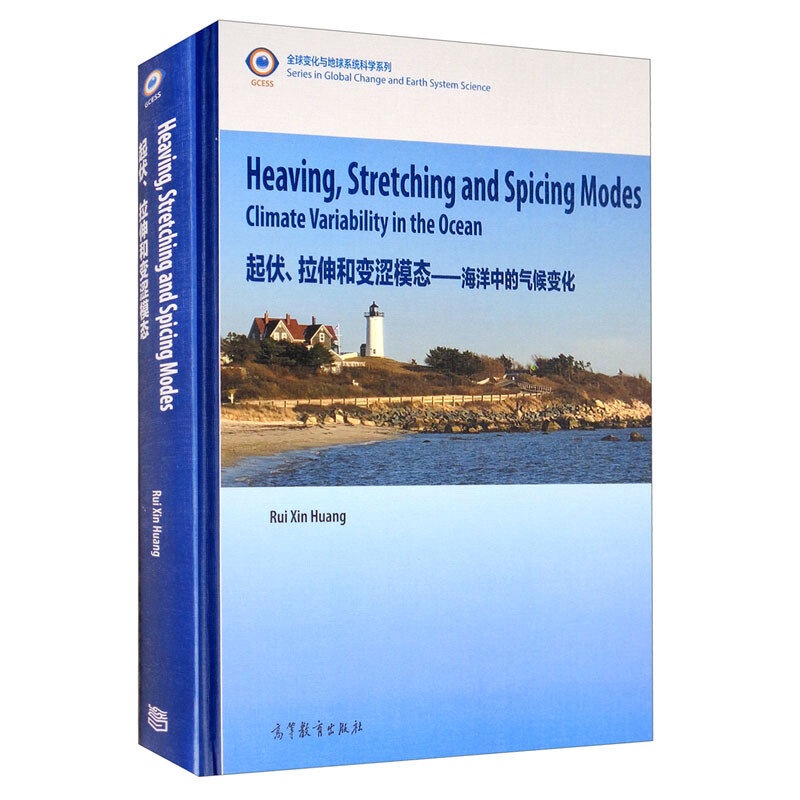
包邮起伏、拉伸和变涩模态——海洋中的气候变化

- ISBN:9787040542554
- 装帧:一般胶版纸
- 册数:暂无
- 重量:暂无
- 开本:16开
- 页数:391
- 出版时间:2020-10-01
- 条形码:9787040542554 ; 978-7-04-054255-4
内容简介
This book is focused on fundamental aspects of climate variability in the ocean, in particular changes of the wind-driven circulation. The vertical movement of isopycnal (isothermal) layers, including their stretching and compression, is called heaving and stretching. A major part of climate vanability in the ocean is heaving in nature. Heave is primarily associated with the adiabatic motions of isopycnal layers due to change of wind stress. It is rather difficult to separate the contributions from adiabatic and diabatic processes. Isopycnal analysis has been widely used in climate study; however, it is much more accurate to study the isopycnal layers.-Here climate signals are examined in terms of changes of layer depth, layer thickness, layer temperature/salinity, spicity and others.In addition to the traditional Theta-S diagram, the sigma-pi (potential density - potential ispicity) diagram-can also be used in anatyzing water mass property distribution and climate variability. In fact, a radius of signal can be defined rigorously for signals in the sigma-pi diagram; the combination of isopycnal analysis and evaluation of radius of signal provides a powerful tool in analyzing climate variability in the world oceans.
目录
1.1 Roles of Wind in Climate Variability
1.2 Main Thermocline in the World Oceans
1.3 Reduced Gravity Model, Advantage and Limitation
1.3.1 Model Formulation
1.3.2 The Reduced Gravity in the World Oceans
1.4 Layer Outcropping: The Physics and the Numerical Method
References
2 Climate Variability Diagnosed from the Spherical Coordinates
2.1 Climate Variability Diagnosed in the z-Coordinate
2.2 External/lnternal Modes in Meridional/Zonal Directions
2.2.1 Heat Content Anomaly
2.2.2 Salinity Anomaly
2.2.3 Density Anomaly
2.3 Adiabatic Signals in the Upper Ocean
2.3.1 Adiabatic Adjustment in the Upper Ocean
2.3.2 Adiabatic Wave Adjustment in the Meridional Direction
2.4 The Regulation of MOC (MHF) by Wind Stress and Buoyancy Anomalies
2.4.1 Introduction
2.4.2 Surface Density Anomaly
2.4.3 Correlation Between Surface Forces and MOC
2.4.4 Conclusion
2.5 Adiabatic Heaving Signals in the Deep Ocean
2.6 Final Remarks
References
3 Heaving, Stretching, Spicing and Isopycnal Analysis
3.1 Heaving, Stretching and Spicing Modes
3.1.1 Adiabatic and Isentropic Processes
3.1.2 Heaving, Stretching and Spicing Modes
3.1.3 External Heaving Modes Versus Internal Heaving Modes
3.1.4 Wave Processes Related to Adiabatic Internal Heaving Modes
3.1.5 Local Versus Global Heaving Modes
3.2 Potential Spicity
3.2.1 Introduction
3.2.2 Define Potential Spicity by Line Integration
3.2.3 Define Potential Spicity in the Least Square Sense
3.2.4 Solve the Linearized Least Square Problem
3.2.5 Potential Spicity Functions Based on UNESCO EOS-80
3.2.6 Potential Spicity Functions Based on UNESCO TEOS_10
3.3 σ-π Diagram and Its Application
3.3.1 The Meaning of Spicity
3.3.2 Density Ratio Inferred from the Density-Spicity
Diagram
3.3.3 The σ-π Plane as a Metric Space
3.4 Isopycnal Analysis
3.4.1 The Lagrangian Coordinate
3.4.2 Isopycnal Analysis in the Eulerian Coordinate
3.4.3 Isothermal Analysis
References
……
4 Heaving Modes in the World Oceans
5 Heaving Signals in the Isopycnal Coordinate
6 Heaving Signals in the Isothermal Coordinate
7 Climate Signals in the Isohaline Coordinate
Index
-

造就适者——DNA和进化的有力证据
¥17.5¥55.0 -

昆虫的生存之道
¥12.4¥38.0 -

世纪幽灵-走近量子纠缠
¥9.4¥28.0 -

声音简史
¥25.5¥52.0 -

13次时空穿梭之旅
¥18.7¥59.0 -

古文诗词中的地球与环境事件
¥9.4¥28.0 -

巧工创物〈考工记〉白话图解
¥9.7¥22.8 -

科学之死:20世纪科学哲学思想简史
¥19.5¥50.0 -

舟山群岛植物图志
¥16.9¥59.0 -

数学的魅力;初等数学概念演绎
¥9.4¥22.0 -

现代物理学的概念和理论
¥19.4¥68.0 -

刘薰宇的数学三书:原来数学可以这样学全3册
¥35.2¥118.0 -

递归求解
¥10.0¥28.0 -

成语与地理科学
¥10.6¥30.0 -

博物人生-(第2版)
¥29.1¥78.0 -

星空探奇
¥12.7¥39.0 -

通俗天文学(九品)
¥16.4¥48.0 -

现代科技中的天文学
¥5.5¥13.0 -

化学晚会
¥7.0¥20.0 -

怎样解题
¥17.8¥29.0













